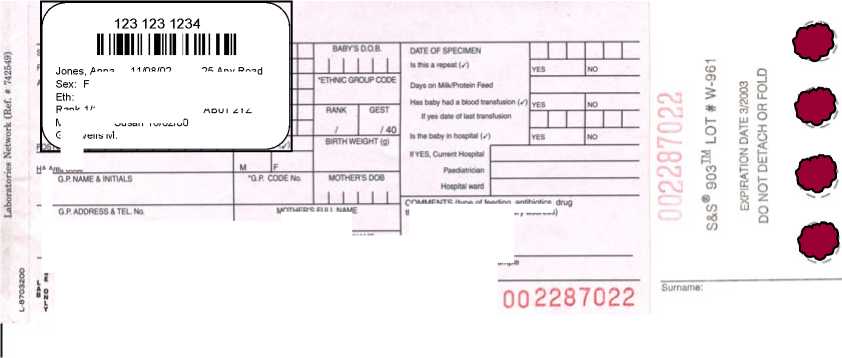The storage and use of newborn babies’ blood
spot cards: a public consultation
Summary
This consultation aims to gather the public’s views on the storage, use and management of
the UK collections of newborn babies’ blood spot cards.
First, this document explains the background to the storage of newborn blood spot cards,
outlines the potential for research and other uses and explains the current management
arrangements for the UK collections of these cards (see Section 1). Second, it provides
information about the different uses, and asks for your views about these uses (see Section
2). Third, it outlines the current structures for managing the collections of blood spot cards to
serve the interests of the public and keep personal information private (see Section 3).
1.0 Introduction
1.1 What is the UK collection of newborn screening blood spot cards?
In the UK, newborn babies are screened for a small number of rare but serious conditions,
including phenylketonuria (PKU), congenital hypothyroidism (CHT), sickle cell disorders, and
cystic fibrosis (CF). When babies are about a week old blood spots are collected from their
heel onto blood spot cards (see below) and used for testing. Also included on these cards is
basic information about the baby, such as the baby’s name, date of birth, contact details and
NHS number.
Newborn blood spot card (this picture is about half the size of the real cards)

Jones, Anna
MOTHERS FUU-NAML
BAfiYSALTERHATfVE SURNAME
'Complete rf required
by local laboratory
11/08/02
Gest: 40
BWT 3660g
Rank 1/1
Mot: Jones, Susan 16/02/80
GP: Wells M
25 Any Road
Any Place
Any Town
AB01 2YZ
XAAzwCo⅜
u Normal
• Rwnytatorama (✓) □
HypotoyroKtan (✓) □

COMMENTS (Type <X tooβng ∙rtf*-obc∙ druŋ
toarapy. tam∙y hwtory. Wmporary adttaM∣
Nama ot MW HV Wimg aampN
(PR1NT∣
The aim of newborn blood spot screening is to prevent serious disability and even death,
through early identification and treatment of these conditions. More information about the
screening programme can be found at www.newbornscreening-bloodspot.org.uk/
Newborn blood spot screening began in the late 1960s and in some areas blood spot cards
have been stored since then. In 2004 following a widespread public consultation, the UK
Newborn Screening Programme Centre recommended that blood spot cards should be
3
More intriguing information
1. What Drives the Productive Efficiency of a Firm?: The Importance of Industry, Location, R&D, and Size2. Internationalization of Universities as Internationalization of Bildung
3. The name is absent
4. Rural-Urban Economic Disparities among China’s Elderly
5. The name is absent
6. EMU's Decentralized System of Fiscal Policy
7. Modeling industrial location decisions in U.S. counties
8. The name is absent
9. Evidence on the Determinants of Foreign Direct Investment: The Case of Three European Regions
10. Credit Markets and the Propagation of Monetary Policy Shocks